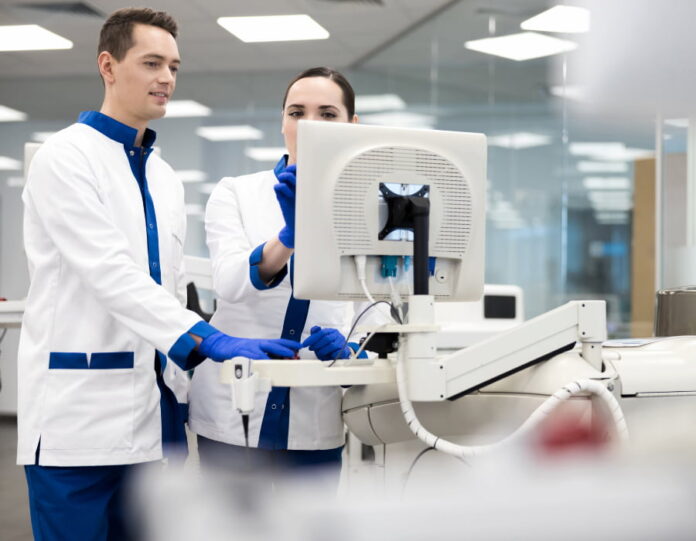Total laboratory automation is considered to be a game changer in the world of clinical laboratories. These innovative systems are revolutionising the way laboratories perform and are being rolled out in clinical labs around the world.
In this article, we’re going to outline the pros and cons of total laboratory automation (TLA) and highlight how it may impact microbiology.
What Is Total Laboratory Automation?
Total laboratory automation is an innovative system that is designed to seamlessly automate manual processes and highly repetitive tasks in a laboratory setting.
Software, laboratory instruments and automated equipment including robotics are custom-built to meet the needs of the laboratory. Once they have been successfully implemented, minimal human intervention is required.

What Are The Benefits Of Total Laboratory Automation?
Lie most technological breakthroughs, total laboratory automation has a wide range of benefits. For example, TLA systems can significantly increase efficiency by reducing human errors, improving the speed of testing procedures and allowing for a higher quantity of repetitive tasks to be carried out at one time.
Total laboratory automation also ensures consistent quality by improving accuracy and reducing questionable results. In addition, total laboratory automation can reduce laboratory spending costs in the long run by eliminating costly manmade mistakes and reducing the need for more laboratory staff members.
Are There Any Downsides To TLA Systems?
Despite being beneficial for laboratories, including microbiology laboratories, total laboratory automation also has its downsides. The introduction of a streamlined automated way of working will significantly change the landscape of a busy lab by reducing the need for as many team members.
This may also lead to the microbiology industry having few clinical laboratory experts who are skilled and knowledgeable in specific processes.
Another downside to total laboratory automation is the high cost of installing and implementing the system. Changes will have to be made to the clinical laboratory to make space for the large hardware required.
From powerful air conditioning units to soundproofing, the environmental modifications required to install a TLA system will be costly. As is the TLA system itself! The laboratory will also have to pay for ongoing maintenance and supplies needed to successfully run the total laboratory automation.
As well as the high installation costs, the implementation of a TLA system will also be disruptive to the laboratory. Implementing a TLA system requires in-depth planning and may take weeks or even months to fully complete. This can be incredibly disruptive to the team working in the clinical laboratory.
How Will It Impact The Microbiology Industry?
Total laboratory automation systems are becoming increasingly popular within clinical microbiology laboratories.
By automating sample handling and preparation, improving data management and automating overall workflow with the use of integrated instruments, robotics and mechanisation, TLA systems offer a wide range of benefits for microbiology laboratories.
One of the biggest impacts is the improved speed and efficiency of results. Total laboratory automation systems also enable microbiologists and laboratory technicians to improve their identification and testing procedures, whilst increasing the speed of achieving desired results.
Did you find this article helpful? You can check out our website for more awesome content like this.
Read Also
- Why Whole Slide Imaging Shapes the Future of Digital PathologyWhole slide imaging has become one of the most important developments in modern pathology. It changes how tissue is examined, how cases are shared and how pathologists collaborate with the wider care team. More than a technological upgrade, it represents a shift in how laboratories think about their workflow, their storage needs and the tools… Read more: Why Whole Slide Imaging Shapes the Future of Digital Pathology
- Comparing 2025 Dental Practice Management Software OptionsSoftware Key Strengths Potential Limitations Best For Dentimax • Offers both cloud-based and on-premise/server deployment. • Tight integration between imaging (e.g. X-ray sensors) and practice management, charts, treatment planning, imaging all in one. • Transparent pricing and relatively simple UI/usability; solid for small to medium general practices. • May lack some of the… Read more: Comparing 2025 Dental Practice Management Software Options
- Top Innovations in Dermatology and Skincare TechnologiesHave you ever wondered how skincare keeps getting better year after year? From fighting acne to reducing wrinkles, today’s treatments seem more advanced than ever before. The tools and techniques used by dermatologists today are smarter, safer, and more effective than those we had just a few years ago. These breakthroughs don’t just help with… Read more: Top Innovations in Dermatology and Skincare Technologies
- Telehealth and Beyond: Building a Connected Continuum of CareHealthcare is on the verge of a radical transformation. Technology no longer simply supports medicine; it actively shapes how care is delivered and experienced. Achieving a seamless continuum demands more than deploying tools—it requires intentional design, coordinated teamwork, and innovative platforms that adapt to diverse clinical and patient needs. This article explores key strategies for… Read more: Telehealth and Beyond: Building a Connected Continuum of Care
- Optimizing CT Protocols: The Hidden Key to Efficiency and Cost Savings in RadiologyIntroduction: Why CT Protocol Optimization Matters Computed Tomography (CT) is a cornerstone of modern diagnostic imaging, providing critical information across nearly every medical specialty. However, maximizing the value of CT — both clinically and financially — requires more than just advanced hardware. The real secret lies in the optimization of CT protocols. When CT protocols… Read more: Optimizing CT Protocols: The Hidden Key to Efficiency and Cost Savings in Radiology
- The Role of Carbide Burs in Modern Dental ProceduresAs a result of this procedures need to be well coordinated and to this end, precision tools are used by dental practitioners. Among the most essential tools in a dentist’s arsenal are carbide burs, which have revolutionized various aspects of dental work. Today’s dentistry cannot work without these tools as they are both strong, sharp,… Read more: The Role of Carbide Burs in Modern Dental Procedures
- Detection of Diabetic Retinopathy: The AI AdvantageDiabetic retinopathy (DR) is a leading cause of blindness among working-age adults, affecting millions worldwide. The prevalence of DR is alarmingly high, affecting an estimated 34.6 million people globally. In the United States alone, it is estimated that 7.7 million adults have some form of diabetic retinopathy. How Does Diabetes Affect the Eye? Most of… Read more: Detection of Diabetic Retinopathy: The AI Advantage
- Advances in Digital Health: Transforming Modern HealthcareThe healthcare landscape is undergoing a seismic shift with the advent of digital health technologies. These innovations are not just modern conveniences; they are transformative tools that bridge gaps in accessibility, improve patient outcomes, and empower individuals to take charge of their health. From wearable devices to telehealth and artificial intelligence, digital health is creating… Read more: Advances in Digital Health: Transforming Modern Healthcare









